Nice title, eh? Well, it goes with the pictures. Rarely recorded for its acoustic quality but still an integral part of fireworks. Mostly the louder the better.
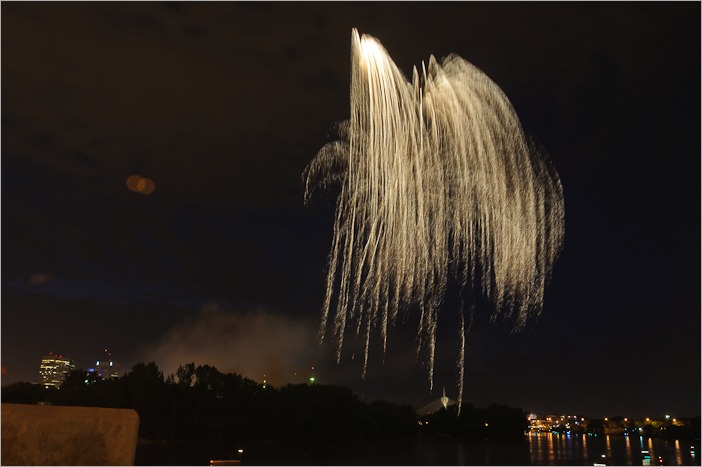 No wonder the boats had to stay away
No wonder the boats had to stay away
Fireworks have intrigued people since their creation, some people love them, some hate them. Some have nice memories, others think of war.
Let’s not go into the memories, but more into the way of capturing them and preserving them as colourful pictures, shall we?
The first thing we need to do, is find a quiet place with a stable surface. Obviously we will need a tripod of decent quality. I use a Giottos VT809 of around 50$. Stability leaves to be desired, and let’s not talk about it being level. It does not keep horizontals horizontal and the same goes for the verticals. Even on a perfectly flat ground. But it does keep the camera in place and without moving. As long as nobody touches it during an exposure.
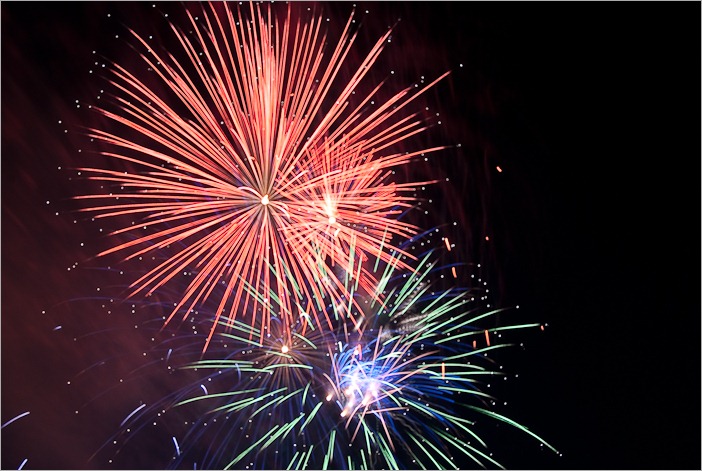 Nice, but out of focus
Nice, but out of focus
Last year I was at the same spot to take pictures with my D40X. I was told to use manual focus, manual aperture, in fact, manual everything. Now, apart from using an old fashioned (but highly effective) split screen for focussing, getting fireworks in focus is rather tricky. They don’t last long enough to focus properly by hand. My results from last year (more than 75 shots) yielded only 2 usable pictures. And even those two will not go on my wall.
 Better focus
Better focus
This year I decided to “lose” the first shot of the fireworks in order to auto-focus on it. Once focussed, the rest was easy. The first thing to do when focus is good is to switch OFF autofocus and not touch the focus ring again during the festivities.
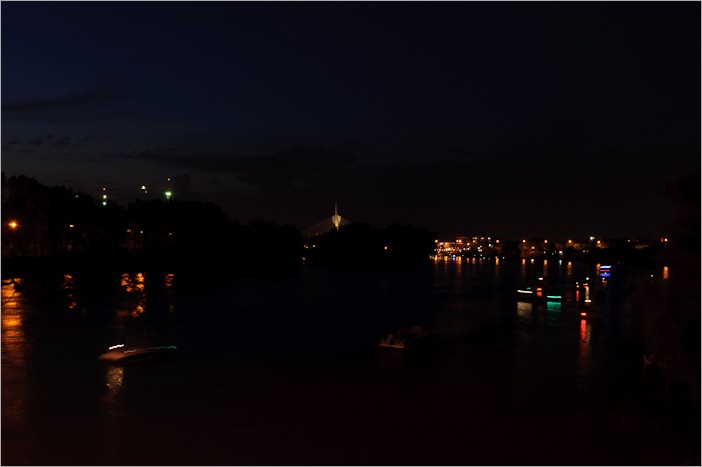 Before the fun
Before the fun
Always shoot a few pictures of the environment before the fun starts, it will give you an idea of what kind of foreground you can get.
Switching autofocus off does not mean everything has to be manual yet. The preliminary shots of the surroundings, when it’s near dark, will give you an idea of what the camera will do if you leave it to its own ideas of getting a perfect exposure. Most of the time you will get clear blue skies, at night(?!?).
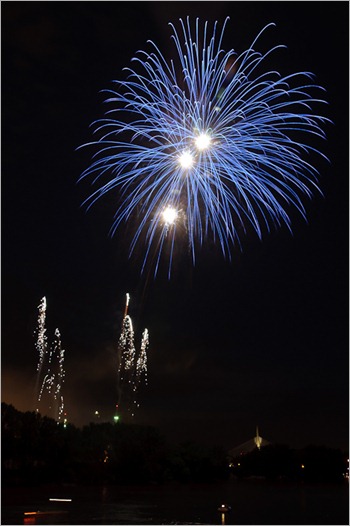 6 seconds is more than enough for a few rockets
6 seconds is more than enough for a few rockets
Obviously you will use faster shutter speeds than the 20-25 seconds your camera proposes, around 5-6 seconds is perfect for most fireworks shots. Like with thunderstorms, you may miss a few but that can hardly be helped. That leaves you with an aperture to set. Don’t forget that even if the camera “told” you before what it was expecting for correct exposures, now your camera should be set entirely to Manual. You set the shutter speed, you set the ISO (as low as possible, in my case 200). You also set the aperture.
For these pictures here, I set it to f/10. f/10 gives me enough depth of field to compensate for eventual “out of focus” events. And believe me it is still open enough to record all the fireworks properly. Also, f/8 – f/10 most often is the “sweet spot” of the lens, producing its best quality pictures at these apertures.
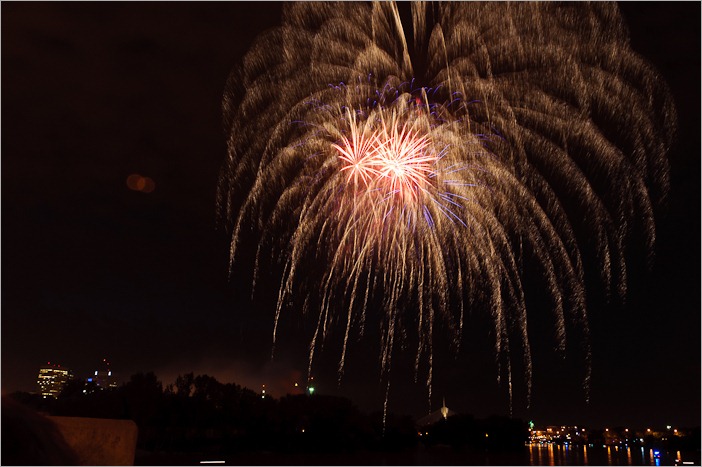 I will have to think of taking a slingshot and a stone for that streetlight next year…
I will have to think of taking a slingshot and a stone for that streetlight next year…
You will need to avoid any street lights in front or near the camera to avoid ghosts and lens flare.
Now the fun starts. Colourful stars explode and you need to get the most of those. You have already tried to get the best spot in town, you now should also have the best field of view in town.
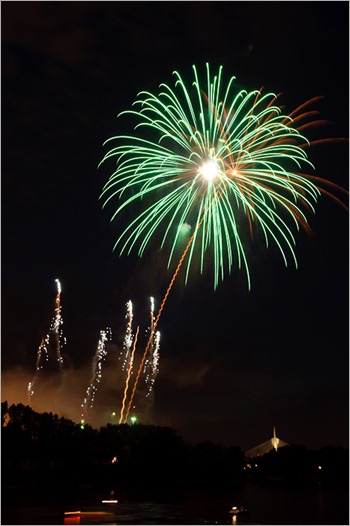 Palm tree
Palm tree
If missing the first two shots of the fireworks will make you miss most of it, better not try to shoot it at all. The Canadian 1st of July, the American 4th of July and Australian 26th of January fireworks are all long enough (around 20-30 minutes at least) to have enough shots. After the first shot you check if everything is ok, in focus and properly framed. If not, re-frame immediately and perhaps sacrifice another of those colourful bursts to get your camera back on track.
Of course having and using a tripod is mandatory for this kind of work, but what comes in most handy is a remote control system for your camera.
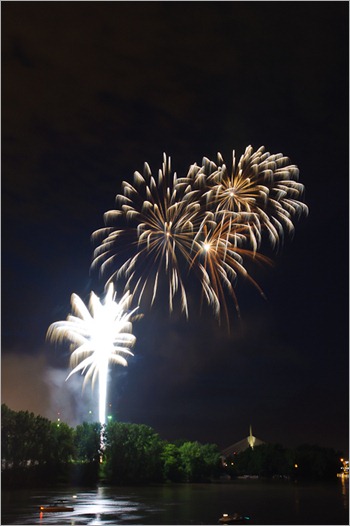 Lots of light, nearly too much
Lots of light, nearly too much
Also, don’t forget to train yourself with this remote control as well as with the settings on the camera. It happened to me that while shooting, the remote became inoperative.
Obviously the timeout of 30 seconds before resuming manual operation was too short for some intervals in the fireworks. Set that timeout to the maximum your camera supports and you can continue to shoot properly. I had to re-arm my remote settings a few times during the fireworks. Not the best of ideas and not the best for my mood either.
 Nearing the end
Nearing the end
Now that the camera is primed for perfect pictures, get your remote and fire away. Often enough you can see the rockets go up in the air before they explode, so that’s what you will be looking for. Open the shutter and enjoy the best pictures you will have of the evening.
Enjoy the fireworks too, they are often presented by the best company in town, in Winnipeg this was Archangel Fireworks Inc.
For me it was “Happy Canada Day!”
